Items tagged with 'cycling'
Bike share grew in both use and reach this year -- here's what CDTA's thinking about for next year
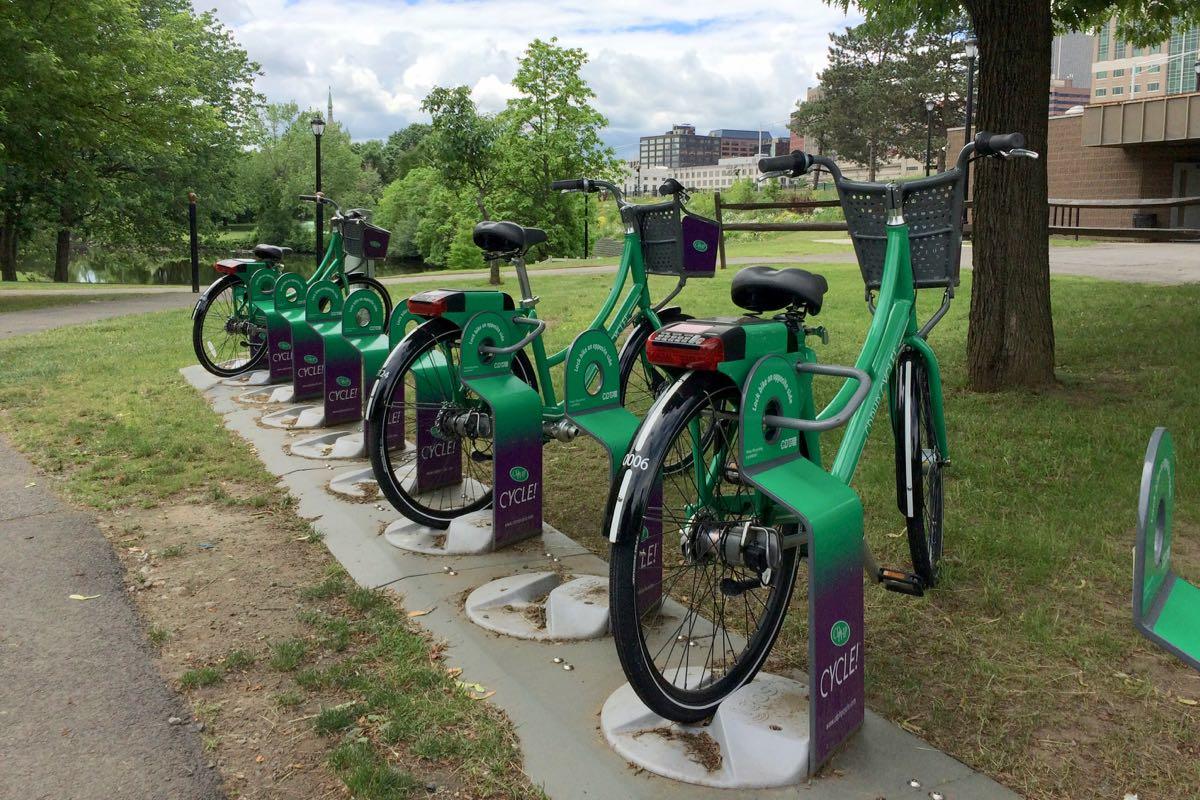
The bike share rack in Corning Riverfront Park in Albany was the most active hub in the system this past season.
The bike share run by CDTA -- CDPHP Cycle -- wrapped up its second season last week, and the transit org reported this week that people took 23,535 trips on the bikes between April and the end of November. That's more than double the total of last year's season.
CDTA pushed to expand the program this year, doubling the number of bikes to more than 300, and increasing the number of rack locations from 40 to more than 70 across larger service areas in Albany, Schenectady, Troy, and Saratoga Springs. It also managed to get more than 4,000 new members for the system, bringing the total to almost 6,600.
And here's what CDTA's thinking about for next year...
(Also: The most popular hub locations and a few other numbers.)
Albany is set to build the link between Helderberg-Hudson Rail Trail and the Mohawk-Hudson Bike-Hike Trail -- here's the plan
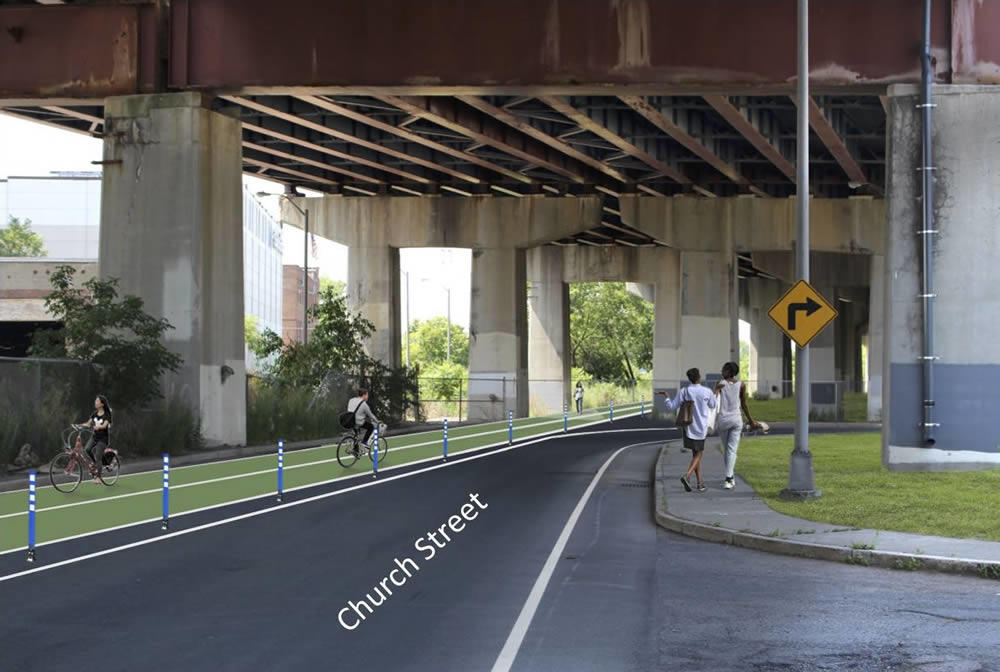
What part of the trail underneath 787 could look like.
The city of Albany is planning to start construction next year on the much-anticipated link between the Helderberg-Hudson Rail Trail and the Mohawk-Hudson Bike-Hike Trail.
The South End Connector is a key piece of the region's growing network of alternative transportation paths. When finished, it will offer a protected path for cyclists and pedestrians along the two miles from the rail trail's South End trailhead and the Mohawk-Hudson trail on the Hudson River. And it holds the potential to offer people within the South End a safer way to the riverfront.
The South End Connector has been in public planning for more two years, and the idea for the trail stretches back even farther. The city unveiled the construction plan and a new timeline last week at a public meeting.
Here's a look at what's in the works...
Here are some of the options for remaking upper Washington Ave in Albany
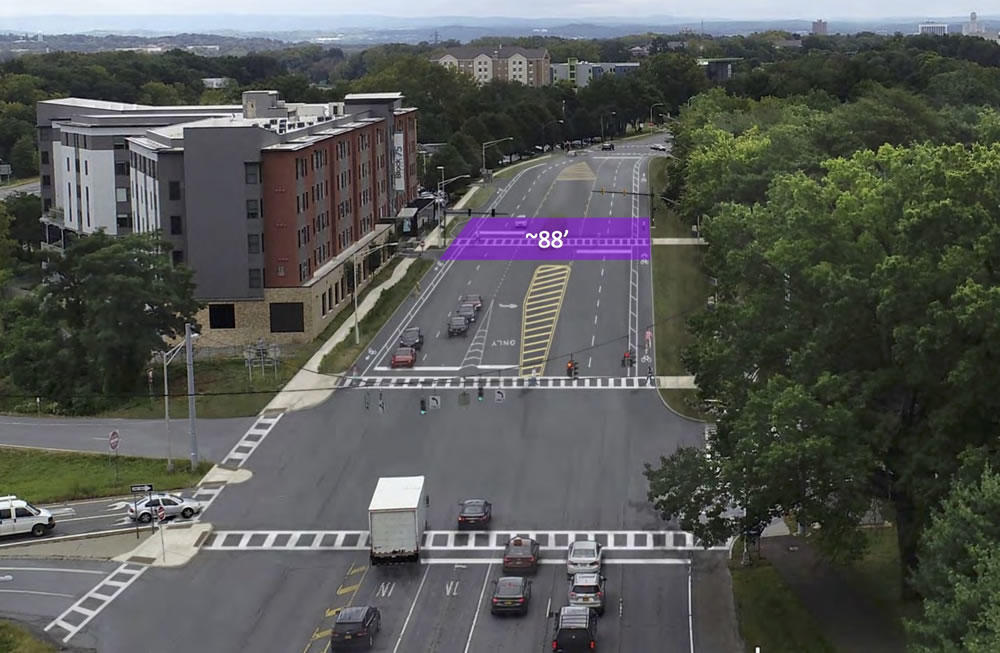
One of the options would re-stripe the road to include bike lanes.
The part of Washington Ave by UAlbany and the Harriman State Office Campus is a weird stretch. It's really wide. All sorts of ramps slip on and off it. There's been a lot of development, but it's hard to get from one thing to another. Pedestrians dart across it. And the speed limit probably feels frustratingly slow for drivers.
So: Are there ways to fix some of these issues, making the street work better and feel better for all sorts of people -- pedestrians, cyclists, drivers?
For the past six months the Washington Avenue-Patroon Creek Corridor Study -- a collaboration between the Capital District Transportation Committee, city of Albany, University at Albany, and engineering consultants -- has been looking into that question.
And Thursday evening during a crowded public meeting at UAlbany the engineers showed off a trio of possible designs for making over the road...
Making it someone's job (literally) to push Albany toward streets that are safer and friendlier for all sorts of people

Update: Kathy Sheehan tells Amanda Fries the city won't be adding the position, but will be assigning one of its current engineers to oversee complete streets and ADA compliance. [TU]
____
Should the city of Albany have a staff member whose full-time job is to keep the city on track towards its goal of creating streets that are safer and friendly to pedestrians, cyclists, and people with disabilities?
A group called Capital Region Complete Streets is pushing for the city to create such a position -- a complete streets coordinator -- and it would like to see the job included in the budget the city's working to finalize. The group has posted a doc outlining its argument (also embedded below). A clip:
It is evident that the City of Albany is making some progress with ADA Compliance, Complete Streets, and combating climate change, but the progress is slow. A Complete Streets Coordinator will help move things forward more efficiently, leading to a more inclusive, safe, walkable, and inviting city. One indicator that this position would be useful is that the city has had a Bicycle Master Plan in place since 2009, nearly a decade, yet has not come close to establishing a connected bicycle network. In fact, since 2009, the city has only managed to construct 4 mostly unconnected bike lanes (Clinton Ave, Northern Blvd, Madison Ave and Ten Broeck) that amount to about 2.8 miles.
A leading 21st century city is a safe and inviting place to live and work. Walkable streets, and navigable bike and transit networks are hallmark quality-of-life essentials for today's families, students, businesses and innovators. A Complete Streets Coordinator will allow Albany to be more responsive to the needs of its residents, while increasing its competitiveness with surrounding communities.
The city already has an ordinance requiring it to work toward "complete" streets, and a few years ago it put together what's essentially a recipe book for laying out streets with pedestrians and bikes in mind.
The city of Albany is planning to start building that connector between the rail trail and the riverfront next year -- and there's a chance next month to see the plans

One of the renderings from 2017 of what the section under 787 might look like.
The city of Albany will show off the concept plans for the South End Connector Trail at a public meeting November 13 at the Howe Branch of the Albany Public Library.
The South End Connector is planned to be a roughly two-mile path to connect the end of the Helderberg Hudson Rail Trail in the South End with the Mohawk Hudson Bike Hike Trail along the riverfront. The public planning process for the project started more than two years ago, and the city and its consultants unveiled a plan in May 2017.
It's an important project because of the connection it will form between the two popular bike trails and the progress toward building a larger regional trail network. And it also potentially will open a safer way for people in the South End to get to the riverfront.
There are a two bits of news in the city's meeting announcement:
+ The city says it's anticipating that construction of the project's multi-use pathwill start in the summer of 2019.
+ A second phase -- that "include enhancements such as additional lighting and public art to the section of the route that goes under I-787" -- is scheduled for 2020. The city is calling that segment the "South End Connector Underline."
The public meeting is Tuesday, November 13 at at the Howe Branch of the APL (105 Schuyler Street). There's an open house from 7-7:30 pm and a project presentation from 7:30-8:30 pm.
Earlier
+ The plan to connect two major bike paths at the Albany waterfront (2017 May)
+ Plotting a path for the Albany waterfront bike trail connector (2016 June)
+ Mapping out the future for an alternative transportation network in the Capital District (2018 September)
+ Elsewhere: "Miami's Underline underscores potential of park projects" [Curbed]
A little push up the hill
Wrapped into my update this past week about what it's been like to use a bike as one of my primary ways of getting around town was a lament/complaint/whining about pedaling up the rather large hill in downtown Albany.
Because of that -- and because it's Friday afternoon -- here's a video of the CycloCable, sort of a ski lift for bikes, in Trondheim, Norway. (See also this CityLab article about it a few years ago.)
The odds of something like this being built in downtown Albany are essentially zero, and probably for some good reasons. But part of me kind of wants to see it proposed just to watch the reaction to the idea.
I mean, it's no gondola...
A year later I'm still using a bike to get around town -- here are a few thoughts about how that's worked out
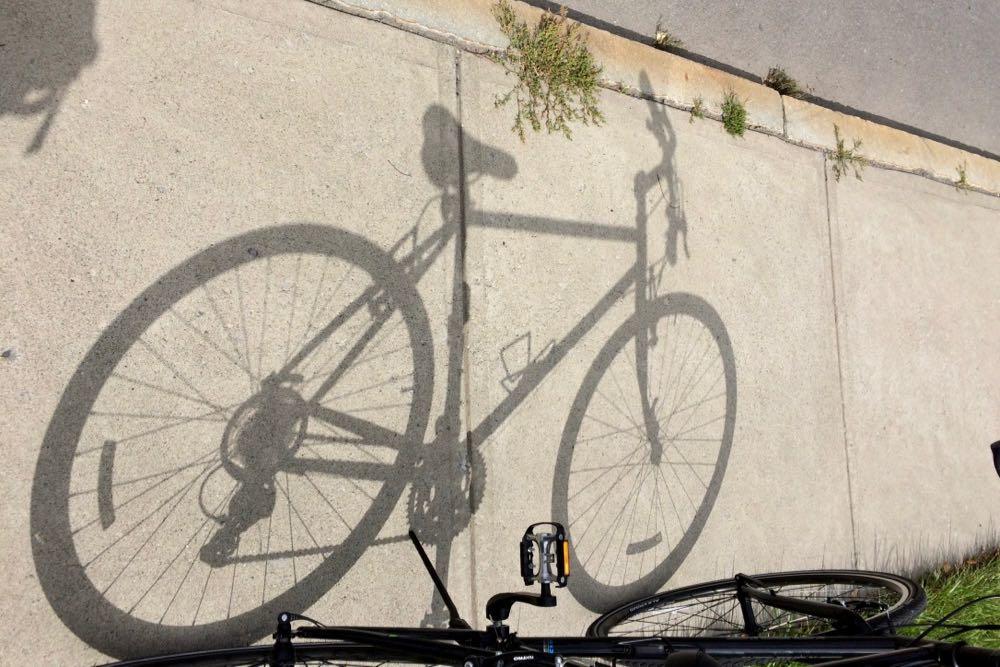
About this time last year I shared how I ended up becoming a person who uses a bike as one of my primary ways of of getting around town.
A year later I am still that person. (Even the Times Union says I'm a cyclist.)
And here are a few thoughts about how that's worked out...
Mapping out the future for an alternative transportation network in the Capital District
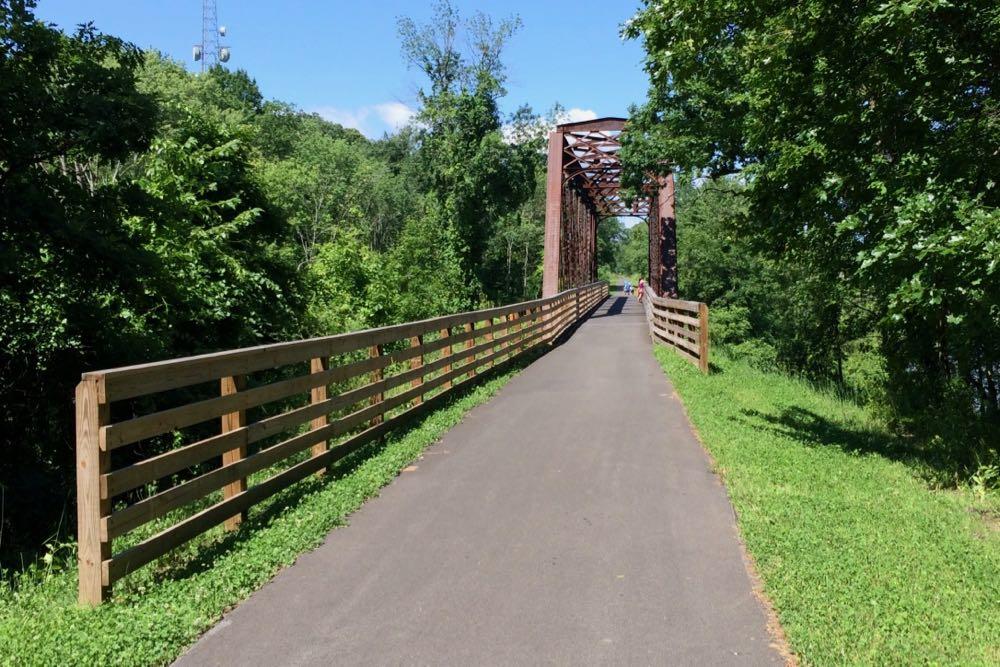
The Capital Region already has a handful of popular biking and walking trails, but if you zoom out a little bit and look at the whole picture you can the see the outline of something a lot bigger.
That something is what Jennifer Ceponis, a senior transportation planner for the Capital District Transportation Committee, describes as an alternative transportation network: "Much like we have a highway system for cars -- with supporting roads and arterials that feed into that -- we want people to be thinking that the region can have a similar system but for bicycling, walking, and other recreational activities."
Toward that goal, the planning org has put together the Capital District Trails Plan, a map toward a future in which you might be able to ride a bike from, say, Voorheesville to Saratoga Springs and beyond on a network of paths.
Here are a few highlights.
The Albany Police Department has e-bikes -- they're still not exactly legal for the rest of us
Thank you, Home Leasing Construction who donated three pedal assist bicycles to the Neighborhood Engagement Unit this morning! Check out Chief Hawkins taking one for a spin on Madison Avenue. #Albany #CommunityPolicing pic.twitter.com/sIVE2sEvNe
— Albany Police (@albanypolice) September 12, 2018
Noted: The Albany Police Department has e-bikes, as that tweet above pointed out this week.
"Pedal-assist" e-bikes are the same sort of bikes that advocates had been trying to get formally legalized in New York State during the past session of the legislature. The push didn't make it over the finish line.
E-bikes are increasingly popular around the country because the little electric motor -- which kicks in when you pedal -- makes it easier to go up hills and maintain speed. So they can be helpful for people who commute by bike, have gotten a little older, and or have a physical limitation that might otherwise keep them from biking. (Also: They're really fun. Riding one feels a bit magical.)
You can buy the bikes in shops here. But they're still not technically legal because of state law. (New York City has pursued its own rules.) That not only puts them in a gray area for regular bike riders, it also means bike share systems won't hop on board with them here, even though the major bike share companies are heading in that direction other places.
Earlier
+ E-bikes stretch the idea of what a bike can be in interesting ways, but they're stuck in a gray area here in New York
+ Another push to get e-bikes up the hill to legalization in New York State
Crossing the Black Bridge
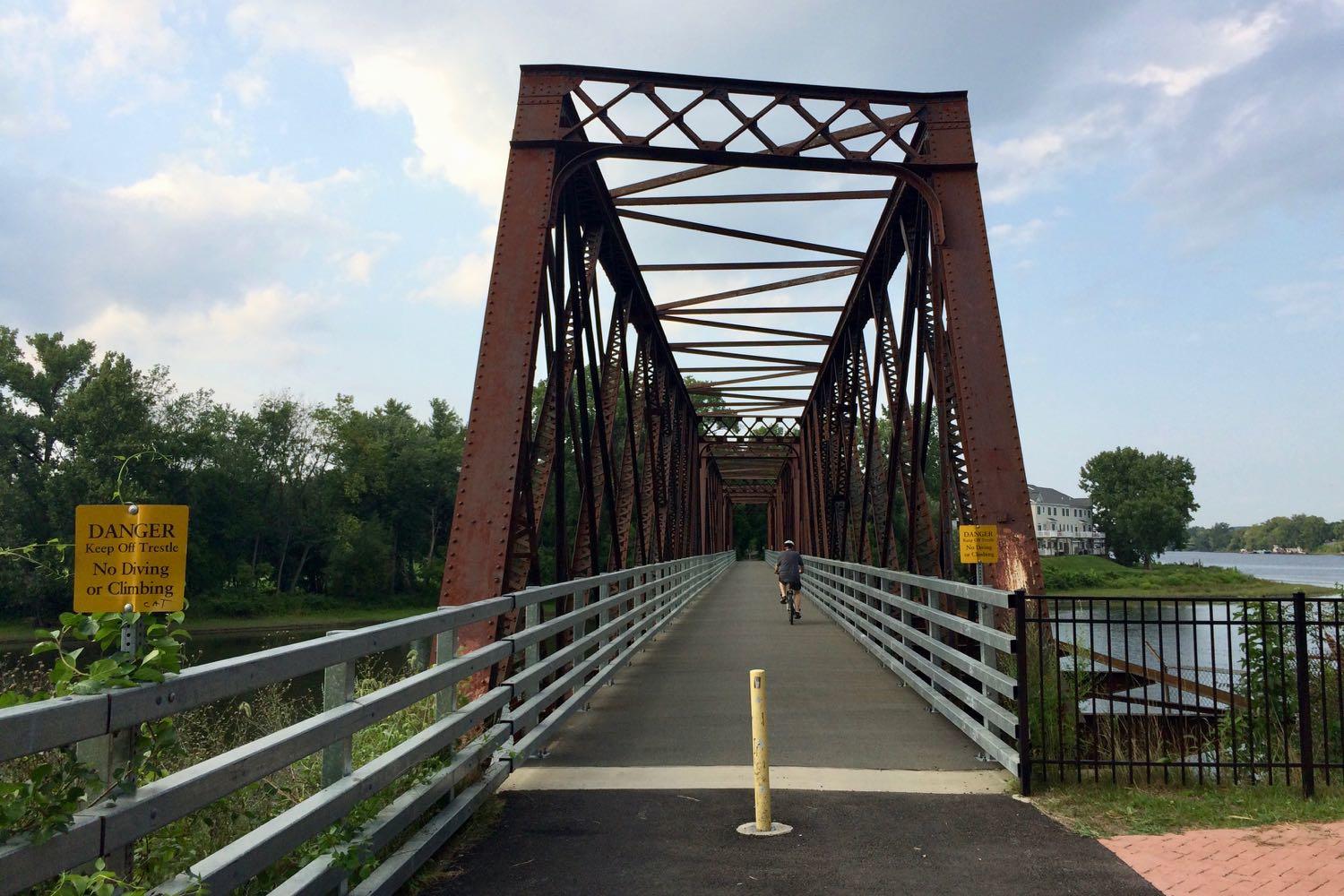
We finally got a chance to check out the new paved path in Green Island that leads up to the southern end of the Black Bridge. And short story short: it's nice.
The Black Bridge is worth checking out sometime if you haven't already. There's a small parking lot at the end of Cannon Street on the Green Island side, and it's a short pedal from downtown Troy via the Green Island Bridge.
The bridge connects Green Island and Van Schaick Island in Cohoes across one of the Mohawk River's curling paths into the Hudson River. And it's part of a multi-use path that connects Green Island, Van Schaick Island, Peebles Island, and Waterford. The roughly two-mile corridor -- the Delaware Ave path in Cohoes -- is a nice walk or pedal as you pass by the fairways of the Van Schaick Island Country Club, the Van Schaick Mansion, a bunch of new residential developments in Cohoes, the old Matton Shipyard, cross the bridge onto the northern end of Peebles Island, and then cross another bridge over to Waterford with a view of the locks.
The setting is beautiful -- and a little bit wild. Late Sunday afternoon we glided past a deer and saw a bald eagle from the Black Bridge.
Unicorn bikes for the bike share, a few ridership numbers for this season so far
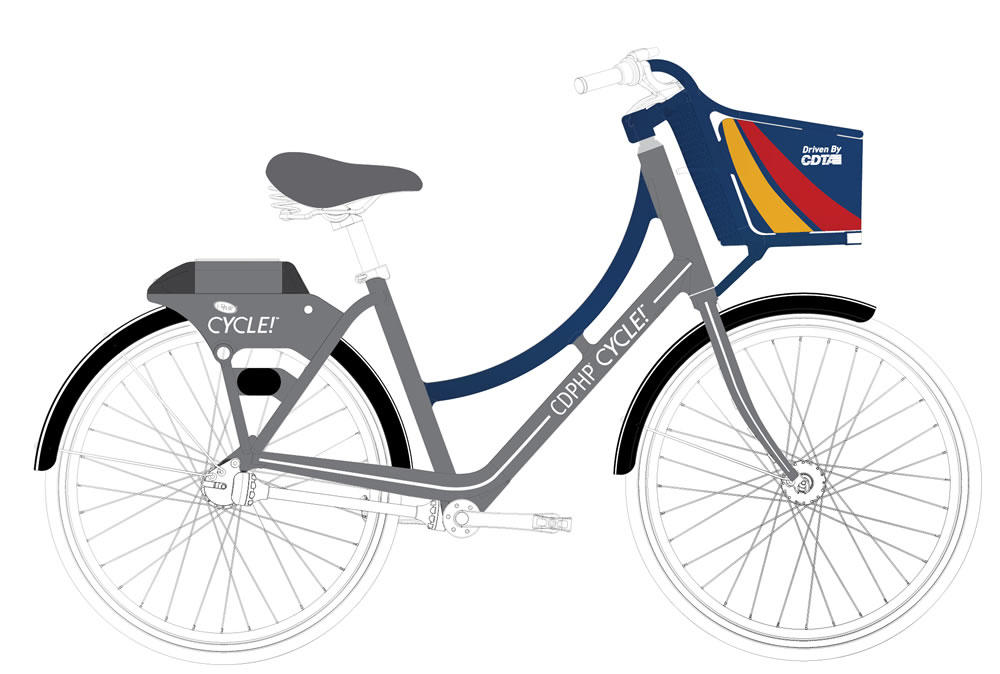
Updated
CDTA announced Wednesday that it will start rolling out "unicorn" bikes as part of the CDPHP Cycle bike share.
The bikes have color schemes different from the typical green and purple of the bike share bikes. The image above is of the design for the CDTA-themed unicorn. There will be six designs in total.
The unicorns bikes are mostly for fun. But trip taken on one this summer, CDTA says it will be making a contribution the philanthropic arm of CDPHP. The Rose & Kiernan insurance agency is also kicking in some money, too.
When we first heard about these unicorn bikes a few weeks back, we expressed our extreme disappointment to CDTA officials that they wouldn't literally be unicorn-themed bikes, with a horn or rainbows or whatever. But there's always hope for the future.
A few more bits about the present and future of the Helderberg-Hudson Rail Trail

The second segment of Albany County's Helderberg-Hudson Rail Trail is now paved -- as noted earlier this week -- meaning there's now 9 miles of (almost) continuous pavement from the South End in Albany all the way out to Voorheesville.
We got a chance this week to talk with Albany County exec Dan McCoy about the present and future of the popular trail.
"I go around doing my state of the county every year, people are like rooting us on -- when's it going to be done, when's it going to be done, when are you going to fix the problem with it," McCoy said in reference to the remarkable popularity of the rail trail. "And these are good issues to have."
Here are a few bits about paving, the depot building in Slingerlands, new amenities, bathrooms, bike share, and what's still ahead...
The second section of the Helderberg Hudson Rail Trail is now paved
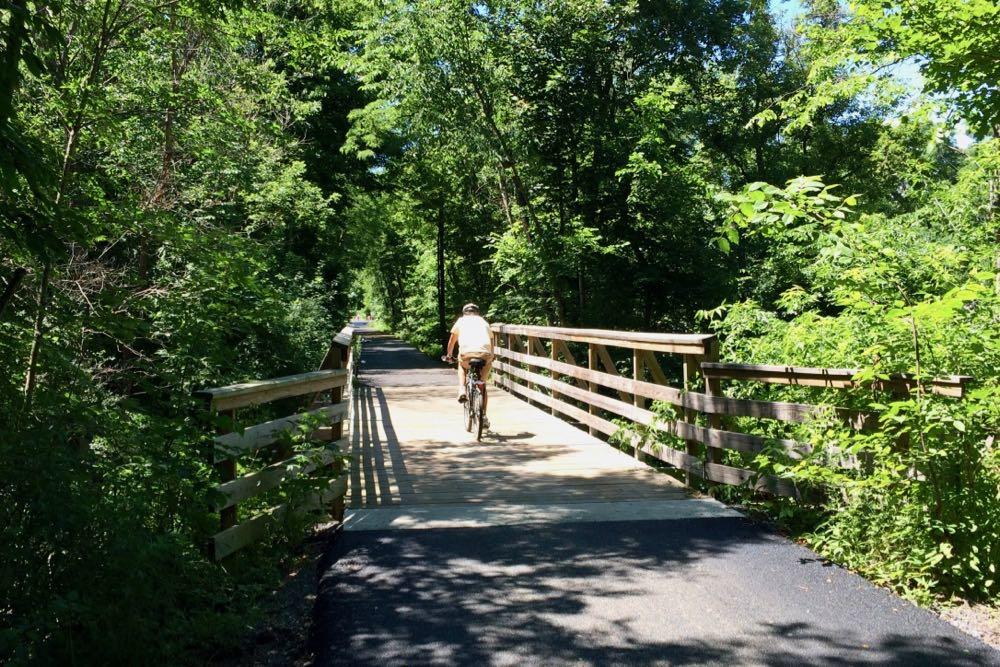
Check it out: The second segment of the Albany County's Helderberg-Hudson Rail Trail -- from Slingerlands to Voorheesville -- is now paved.
We took a spin on the 4-mile segment this Saturday. The newly-paved section starts just west of the Slingerlands parking lot, crosses the Font Grove roads, slices through many shady sections alongside fields with views of the Helderbergs through the trees, passes the Hilton Barn in New Scotland, spans State Farm Road, traverses the Vly Creek, and ends at Grove Street in Voorheesville. The pavement is luxuriously smooth.
That makes (almost) nine miles of continues paved trail from South Pearl Street in the city of Albany out through Bethlehem, New Scotland, and Voorheesville.
The Madison Ave traffic calming project is finished -- so what's next?

The new section of the Madison Ave traffic calming project in Albany -- the "road diet" -- has been in place for more than a week. But now it's press conference-official after an event this past Friday.
"Investments like these help to spur economic development and we need to be focused on growing our tax base, growing businesses, making sure that our neighborhoods are neighborhoods of choice for people so that we can continue to attract them to the City of Albany," said mayor Kathy Sheehan after the event at Madison and South Lake. "So this was about taking that opportunity of looking at the fact that we were going to repave this road and building an infrastructure that helps to make everybody safer."
And people have had a lot to say about this project. During the planning process, during the first phase, and now that it's finished.
So here are a few more things -- about new amenities that aren't bike lanes, about the city figuring out how to implement these sorts of ideas faster, and what might be next.
Cruising along the second phase of the Madison Ave Road Diet
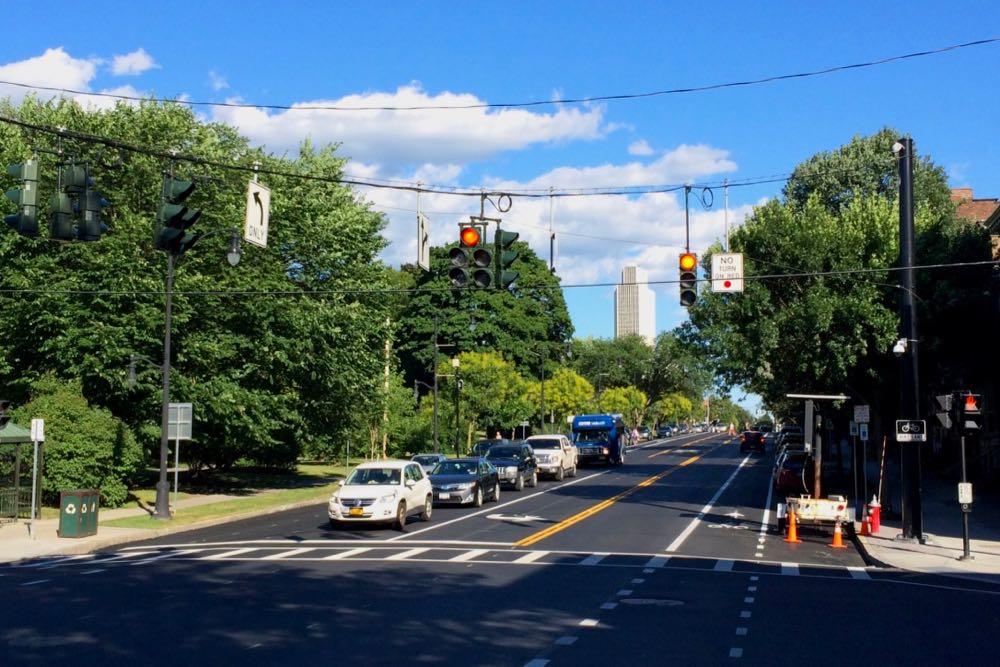
We got a chance to bike along the new section of the Madison Ave traffic calming project late Monday afternoon. New pavement + freshly-striped bike lanes = a nice ride, even alongside plenty of vehicle traffic.
The second phase of the "road diet" stretches from Partridge to Lark. It's part of an overall effort to reconfiguration the Madison Ave corridor from Allen to Lark to increase road safety and amenities for cyclists and pedestrians.
The new layout replaced a four-lane configuration (two vehicle lanes in each direction) with a three-lane layout (one vehicle lane in each direction, with a turn lane in the middle) and bike lanes on each side. Phase two also includes new traffic and pedestrians signals. Those signals are one of the keys to project -- traffic modeling indicated that signal coordination should be able to keep vehicle traffic travel times along the corridor at levels close to the old layout.
The new section isn't quite finished. Some of the striping -- including the zones for buses -- isn't down yet. But the city said Monday that the phase will be completed soon -- probably within the next week or so.
We'll circle back around to the project when it's officially complete (Update: And here's that post.), but just on first look it's remarkable how much different the corridor feels with the new configuration.
Here are a few more pics if you'd like to gawk...
There's a free safe cycling / bike share class coming up in Albany

A bike share hub at Corning Riverfront Park.
The CDPHP Cycle bike share and the New York Bicycling Coalition are offering a free safe cycling class at the Albany Jewish Community Center on June 23. You can register online -- sign-ups close June 21. (Updated. The old deadline had been a typo in the materials.)
Class blurbage:
Refresh your bike skills and get ready to Cycle! The New York Bicycling Coalition will be leading cycling classes to get you ready to ride safely. You'll learn the rules of the road, safety maneuvers, and become acquainted with the CDPHP Cycle! bike-sharing system. All participants will receive a free helmet and a free monthly membership to CDPHP Cycle! This program is brought to you by Capital Coexist.
(Capital Coexist is a local bike and pedestrian safety campaign from the Capital District Transportation Committee.)
It sounds like this class could be good if you're maybe a little uncertain about being on a bike around town and/or you're maybe a little hesitant about how the bike share works.
The class is Saturday, June 23 from 10 am-2 pm at the Sydney Albert Albany JCC (340 Whitehall Road).
Earlier: How I ended up riding a bike as one of my primary ways of getting around town -- and how that's gone
CDPHP advertises on AOA.
An old Northeast city, historic sites, a protected bike track
Farther afield, but interesting in light of conversations here...
Check out this short Streetfilms video about the new Connect Historic Boston Bike Trail -- a protected bike lane that winds its way between historic sites in Boston. (As you might have guessed from the name.)
Boston is not Albany or Troy or Schenectady, obviously. But like the cities here, it is old and (even more) dense and in the Northeast. So apparently it's finding ways to overcome the sorts of issues and complaints that often accompany proposals for this sort of bike infrastructure here -- like the effect on car traffic and parking and snow removal. And there's research that indicates this sort of robust bike infrastructure is both safer and encourages more people to ride.
Anyway, here's a ride-along video of the Boston trail from last month.
By the way: The under-construction South Troy Riverfront Bikeway is in line to get a two-way cycle track like this, which would be the first for this area.
Earlier
+ Albany's sister city bike paradise
+ Another push to get e-bikes up the hill to legalization in New York State
Another push to get e-bikes up the hill to legalization in New York State
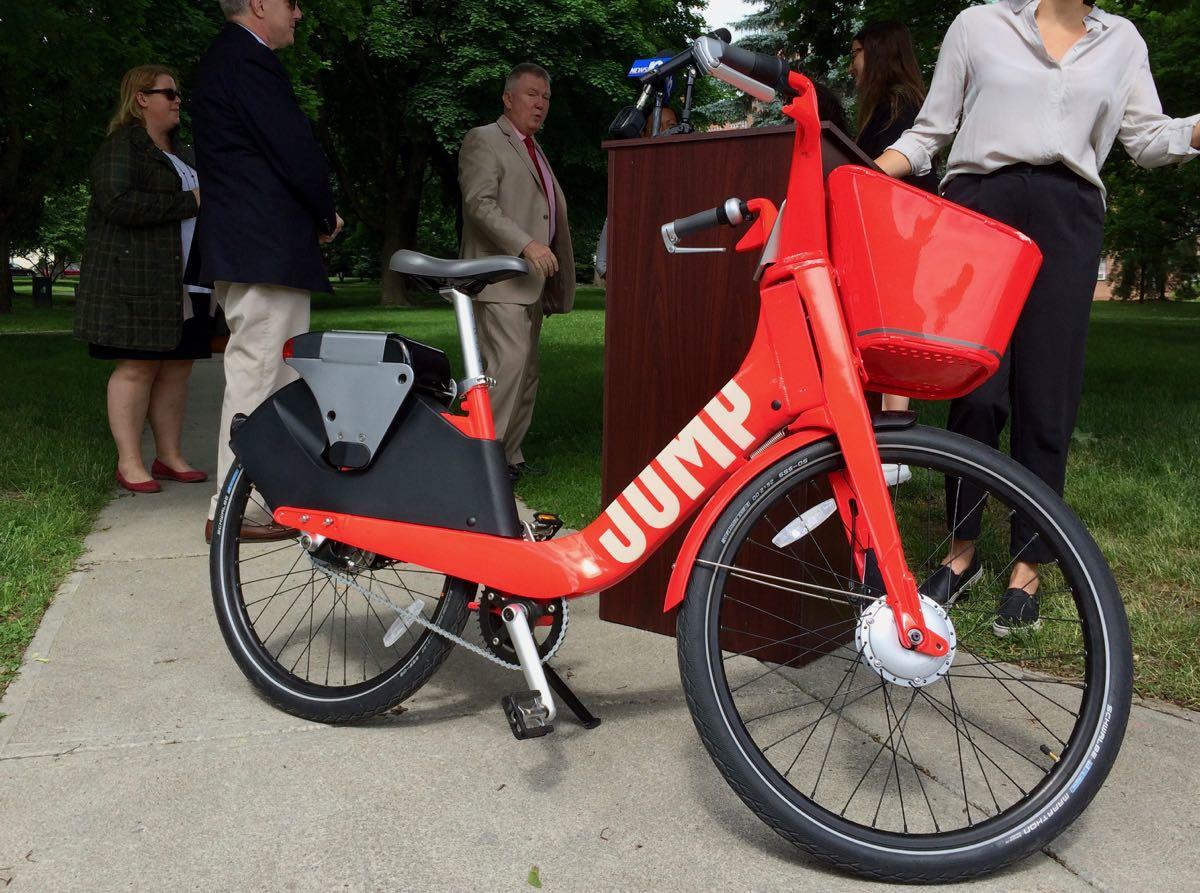
One of Jump's bike share e-bikes.
E-bikes hold the potential to stretch the use of bikes in all sorts of interesting ways, but they're not currently legal in New York State.
There's a push to change that, and advocates are pedaling hard to make it up the hill before the state legislature ends its current session later this month.
On Wednesday reps from the company behind the bike share operated by CDTA were in town to argue the case for e-bikes along with a handful of state and local leaders. The pitch: e-bikes can be a new way for people to commute, they'll open tourism opportunities, and they'll expand the pool of people who ride bikes.
So here are a few bits about how e-bikes might work with bike share in the Capital Region, and a check-in on where things are at in the state legislature...
The Helderberg-Hudson Rail Trail is set to get a new paved section this summer, and a few more bits about its future

Albany County's Helderberg-Hudson Rail Trail is already one of the most popular bike/hike trails in the region, even though it's just a few years old.
And this summer is shaping up to be a big season for the path as the county prepares to pave the segment from Slingerlands to Voorheesville, adding another four miles of asphalt path.
Here are a few things about the future of the trail -- both in the short term and farther out...
How to get to the indoor bike parking at the Empire State Plaza

Pretty much the best parking spot at the ESP.
By the way: There is indoor bike parking at the Empire State Plaza -- on the concourse level, even.
The bike racks are just outside the door to the bus turnaround area in the middle of the concourse, right across from the food court.
Maybe you've seen these racks and wondered how one ever get their bike there, because it's not exactly apparent. (Or you're googling this now.)
Well, wonder no longer.
E-bikes stretch the idea of what a bike can be in interesting ways, but they're stuck in a gray area here in New York
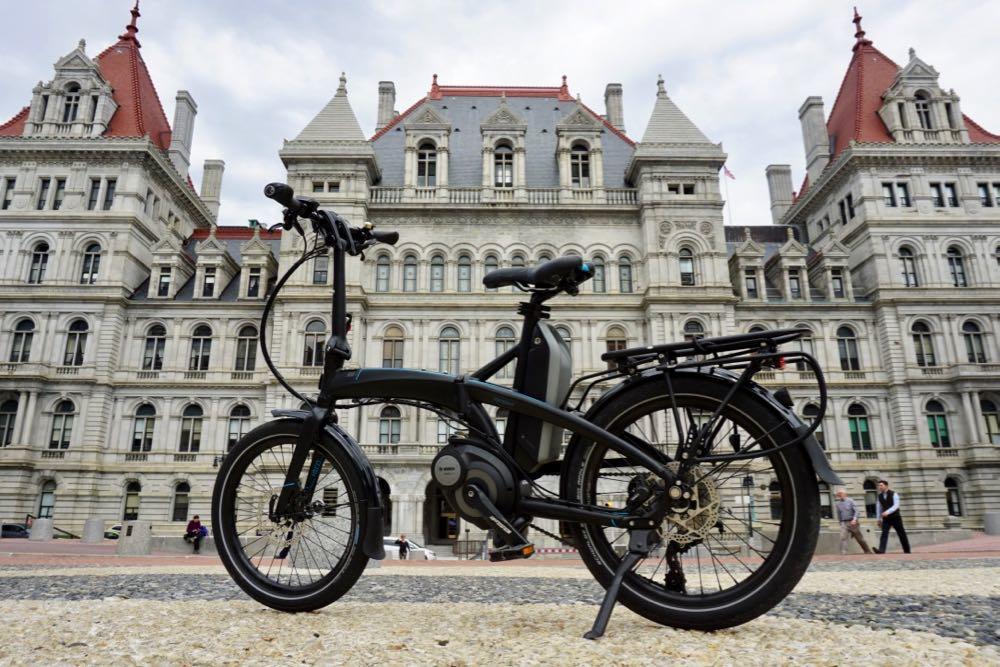
Bikes can be a good way to get around. They don't take up a lot of space on roads. They're environmentally friendly. They're fun.
There are also some drawbacks that prevent people from embracing bikes as an everyday transportation option: the relatively slow speed of travel, the sweat, just the general physical exertion of riding.
E-bikes -- which give riders a little help thanks to an electric drive -- can address a lot of these issues. Riding one feels a little bit like magic. And their popularity is on a big upswing.
But there's a snag: New York State doesn't have clear rules for e-bikes.
And that casts some doubt on their future here.
Here are the new bike share service area maps and hub locations
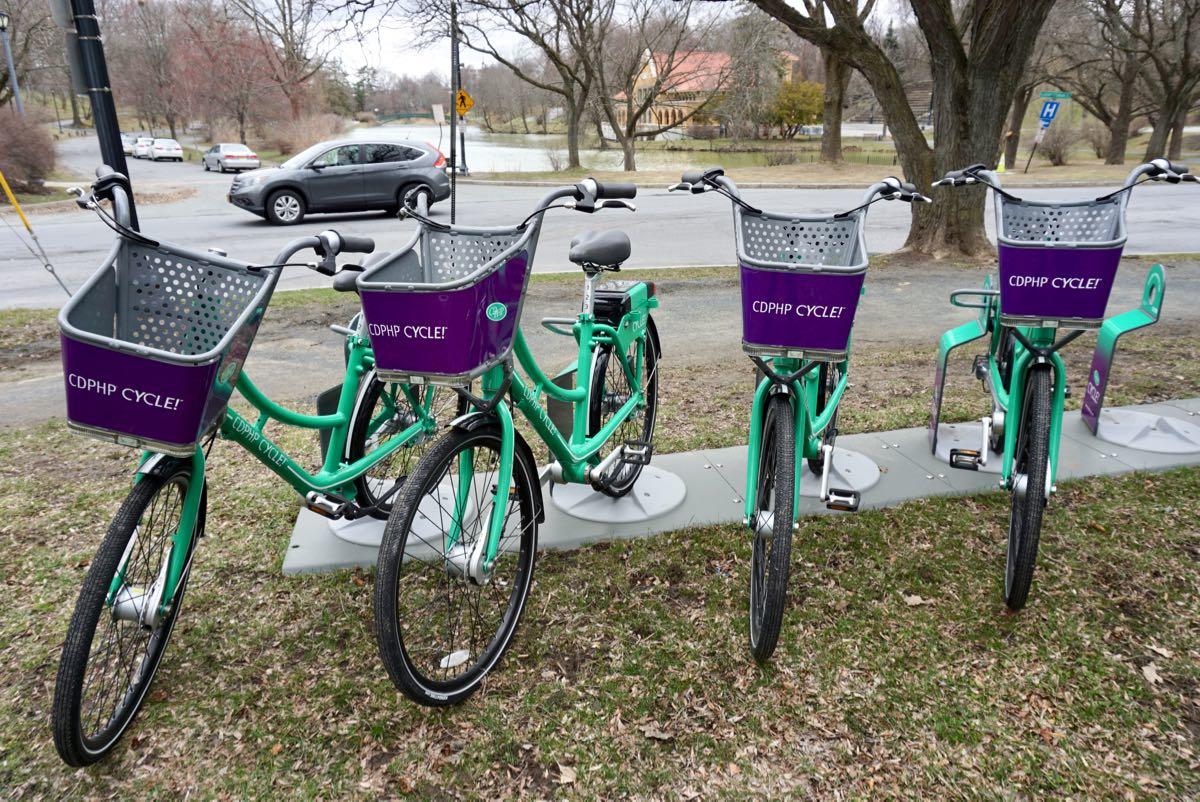
Washington Park is one of the bike hub location holdovers from last year, but this year it has double the number of spaces.
The new season for the bike share operated by CDTA -- CDPHP Cycle -- started in mid-April. And the for the second season, the transit org promised more bikes, more hubs, and a wider service area.
The details for that expansion are now out. CDTA has released maps for this season's hubs -- some already place, some still to come -- as well increased geographic boundaries for the system. The transit org says this season will include 350 bikes (versus 160 last year) and 80 hubs.
The expanded system areas in Albany, Schenectady, Saratoga Springs, and Troy are notable for a few reasons. 1) The relatively compact boundaries for the first season were a frequent complaint. 2) The new boundaries cover much of their respective cities, including more neighborhoods beyond the downtown cores. 3) The "out-of-system" fee for dropping a bike outside the boundary is $100.
See below for maps of the planned rack locations. The bike share's website has the racks that are currently in place (along with counts of how many bikes are available at each location). There's also a mobile app with this info.
The new season of the CDPHP Cycle bike share has started up

The hub in Washington Park is one of the locations that's gotten an expanded 10-bike rack this year.
Check it out: The new season for the bike share operated by CDTA -- CDPHP Cycle -- started Wednesday. Bikes are back out on the racks and they're available to use.
This is the second season for the bike share, and the first full season. (Last year's season started in late July.) This time around includes double the number of bikes (320 vs. 160) and more than 20 additional rack locations. You can see where bikes are available -- and reserve one -- via the bike share's online map or mobile app.
And that early-bird pricing for a full-season membership is still available through April 19. The $65 membership (it's usually $85) includes an hour of bike use per day.
The base price for using a bike without a seasonal pass is $5 per hour (prorated to the minute), with an "out of hub" fee of $2 and a "brought to hub" bonus of $1. (The bikes don't have to returned to a hub. The electronic tech for renting the bikes is on the bikes themselves, and they're equipped with GPS.)
CDTA exceeded its membership goal for last season, ultimately signing up 2,467 people, logging 11,481 trips that averaged 2.34 miles per trip. One of the goals for this season, with the additional bikes and racks, is to expand the service area further into neighborhoods beyond the downtowns of Albany, Schenectady, Troy, and Saratoga Springs.
Earlier: What's next for the CDPHP Cycle bike share
CDPHP advertises on AOA.
There's a discount on CDPHP Cycle bike share memberships right now

The next season of the bike share operated by CDTA -- CDPHP Cycle -- is lined up to start later this spring. And the service is offering early bird pricing.
A season membership is currently $65 through April 19. After that the price increases $20. The membership includes 60 minutes of free bike use per day, so if you think you'll be using the bikes often, this could save you a few bucks.*
The base price for using a bike without a seasonal pass is $5 per hour (prorated to the minute), with an "out of hub" fee of $2 and a "brought to hub" bonus of $1. (The bikes don't have to returned to a hub. The electronic tech for the renting the bikes is on the bikes themselves, and they're equipped with GPS.)
In addition to the season pass, there's a $15 monthly membership that includes 60 minutes of time each day. And there are also student rates, which are half the typical price at each level.
By the way: The "out of system area" fee this season will be $100. (It was $25 in 2017.)
Capital District Trails Plan

The Helderberg Hudson Rail Trail
One multi-use trail for walking and biking is good. Two is better. But a network of interconnected trails is best.
Toward that goal, the Capital District Transportation Committee is working to develop a Capital District Trails Plan, and it's looking for public input:
The Capital District Trails Plan is a strategy to link together the various multi-use trails in Albany, Schenectady, Rensselaer and Saratoga counties into a single connected network of trails for everyone in the region to enjoy. This planning effort will identify existing trail locations throughout the region and work with local communities to envision potential new trail routes which will infill missing segments, connecting to each other and to key points of interest. This plan, sponsored by The Capital District Transportation Committee (CDTC), will involve the input from residents, community leaders and stakeholders through different public meetings, workshops and surveys as they are scheduled throughout the coming year. The goal is to develop a vision for a connected, regional network of multi-use trails that is accessible to all Capital Region residents.
Here are a few ways to offer input, whether it's a public meetings*, a survey, or a crowd-sourced map (check out the "trail concept" for a loop through Albany off the Helderberg-Hudson Rail Trail).
Paths such as the Mohawk Hudson Bike-Hike Trail and Albany County Helderberg-Hudson Rail Trail are already popular. And there are some interesting projects like the Albany Waterfront Connector and the Albany-Hudson Electric Trail in the works. From our perspective, one of the challenges/opportunities now is figuring out ways to connect local neighborhood routes to these paths so they can be more useful as transportation corridors and just offer more general access.
* Maybe these meetings could have been scheduled at times that would have made it easier for people to attend. Update: We hear these meetings are primarily for trail groups, planners, and public officials.
... said KGB about Drawing: What's something that brought you joy this year?